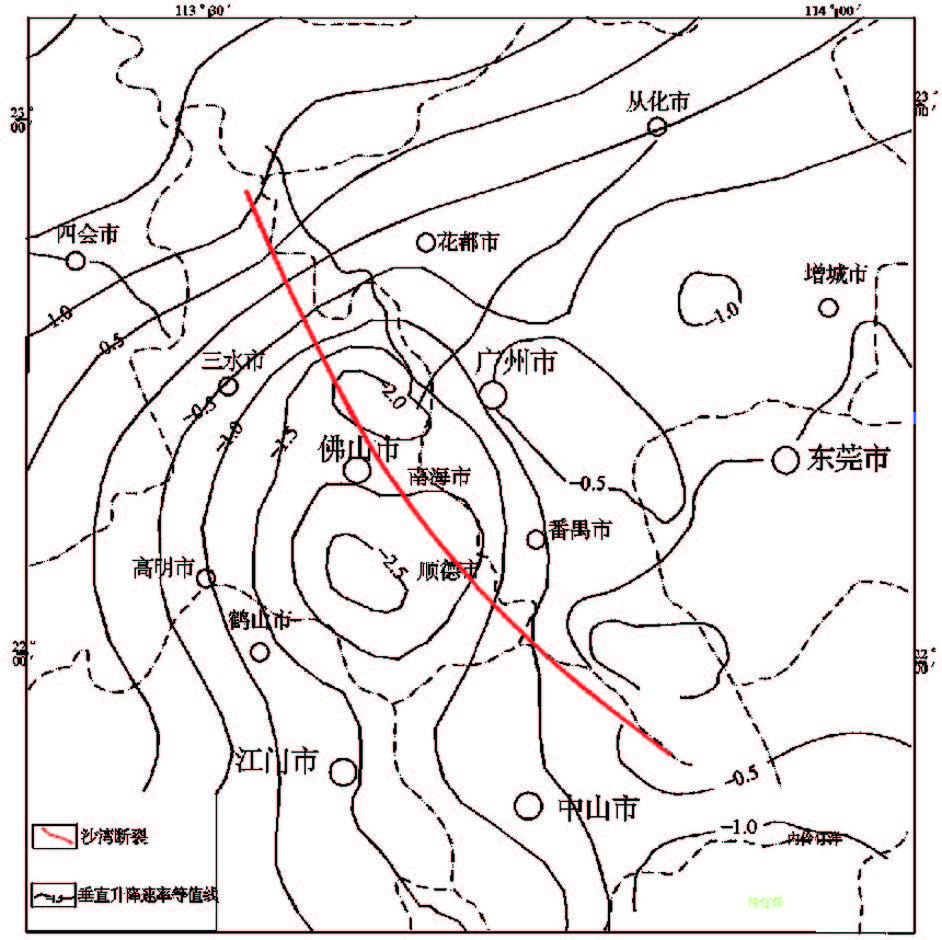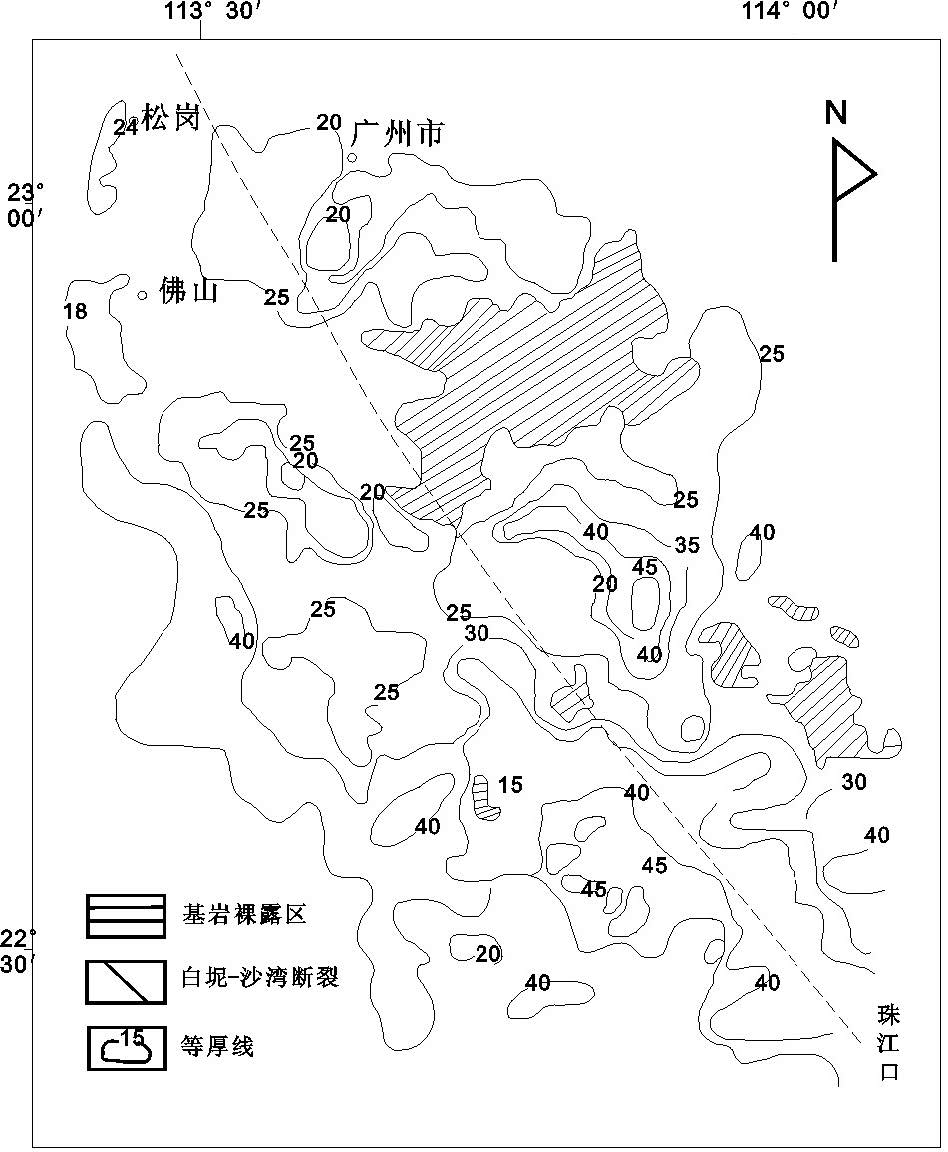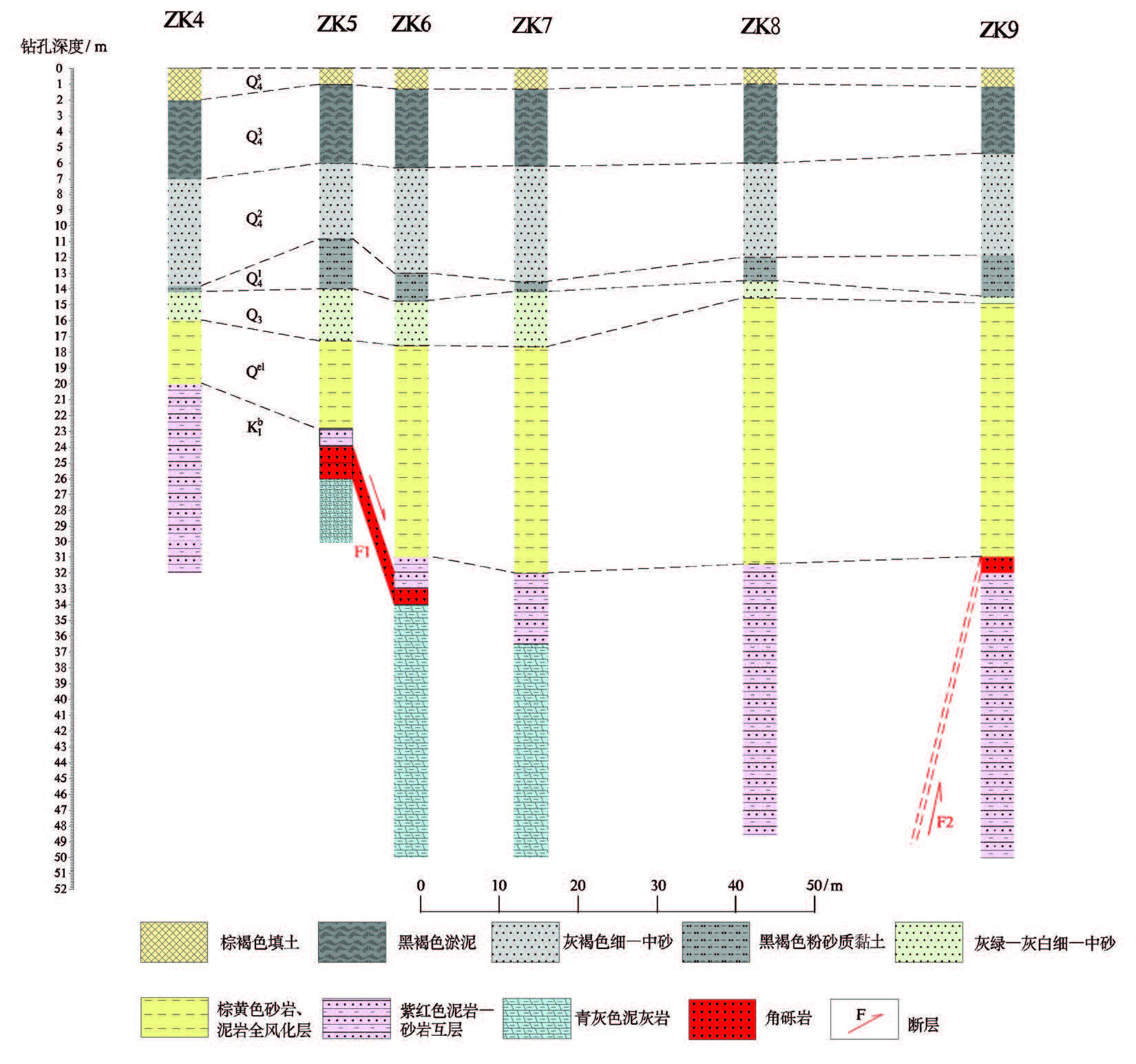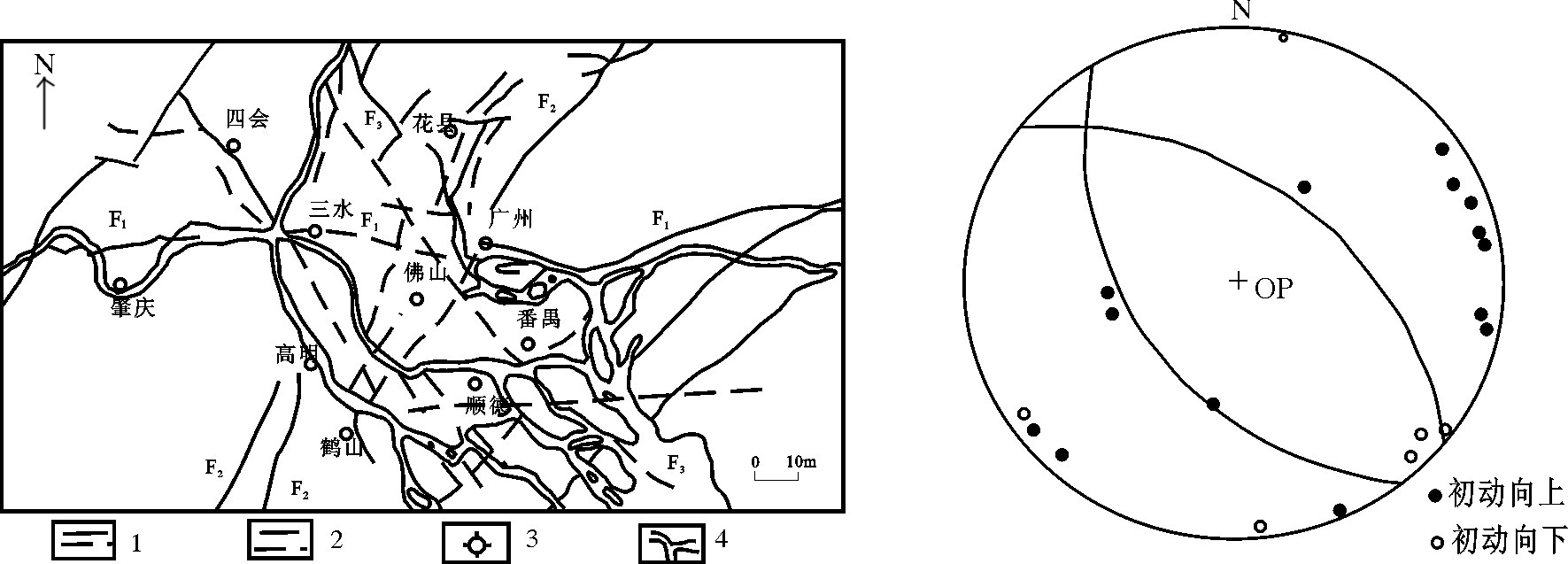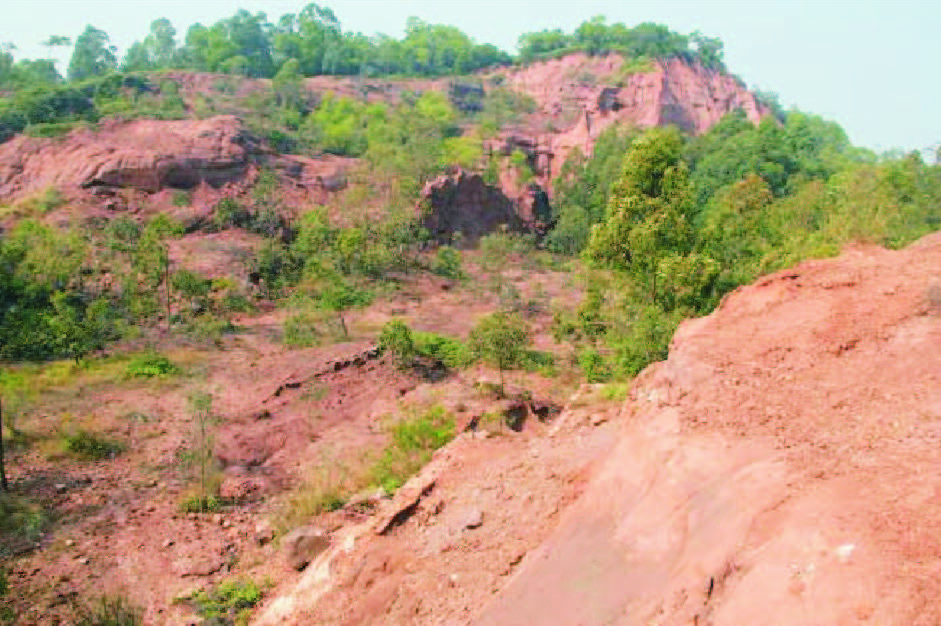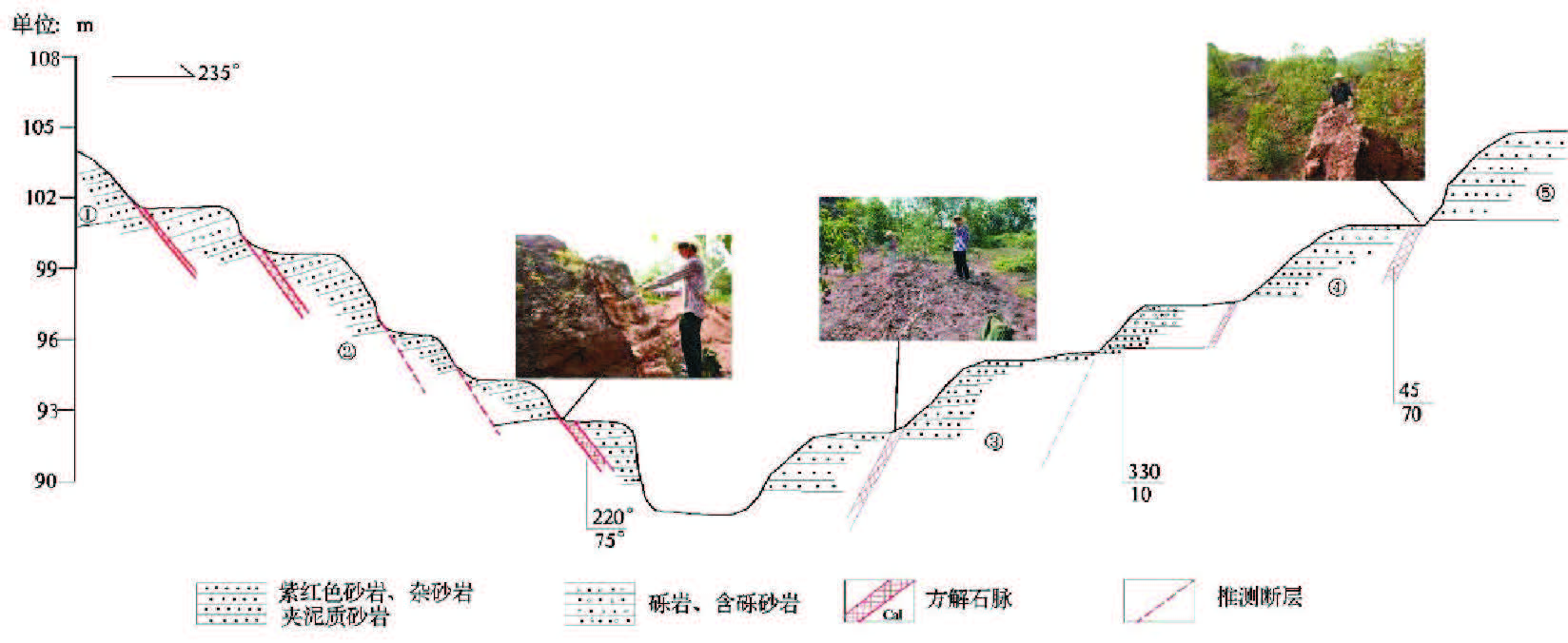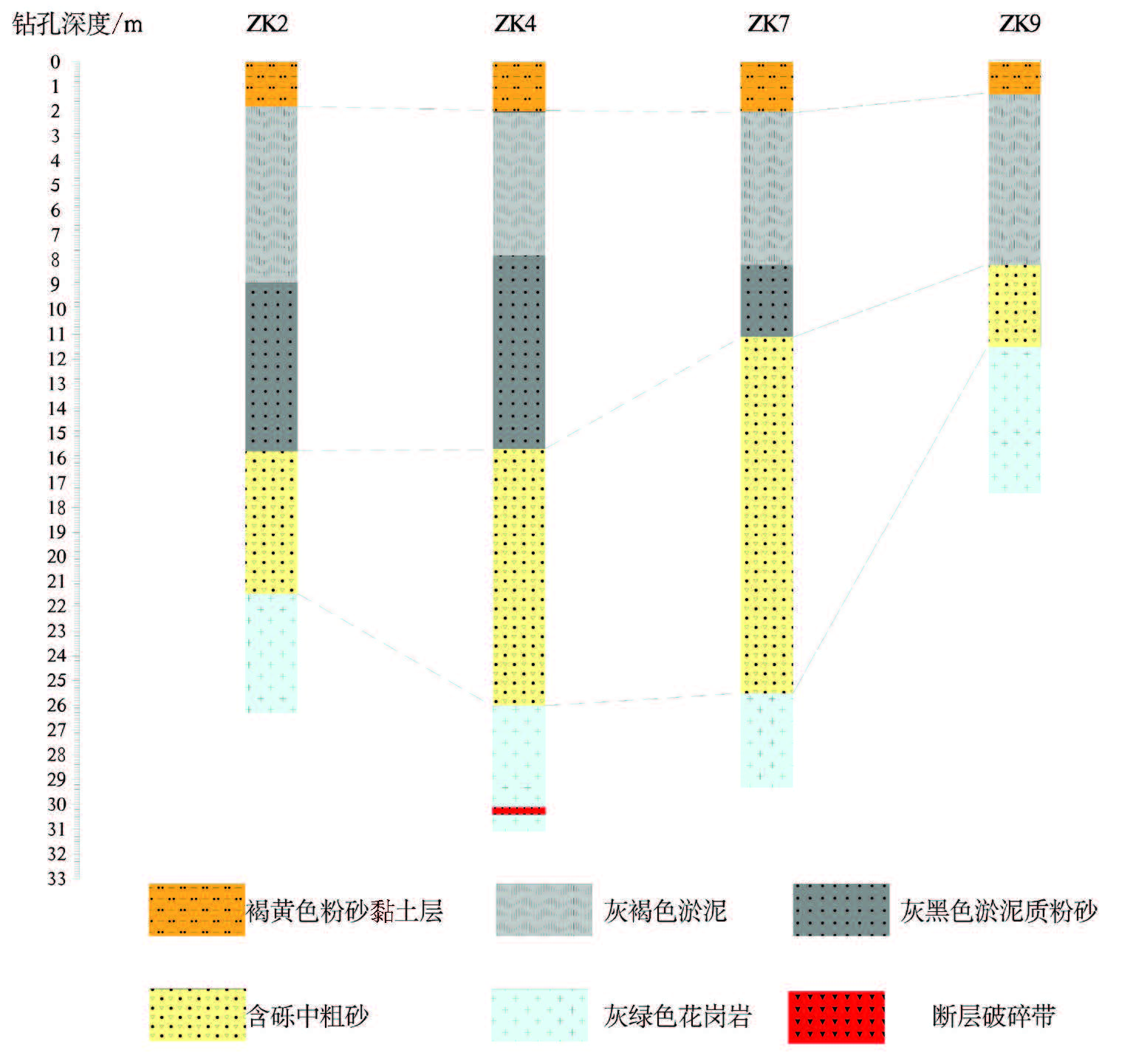-
摘要:
沙湾断裂是珠江三角州北西向的主干断裂。为了查清其第四纪活动性,我们进行了1∶5万地质地貌填图、断层活动年代测定、氡气测量、浅层地震勘测和联合钻孔验证及构造解析等工作。第四纪地貌与断裂的耦合性及历史地震情况说明,沙湾断裂目前仍有一定活动性;地质调查及勘测未发现断裂切割第四系,氡气测量结果表明断裂目前活动性中等以下,说明沙湾断裂目前活动性较弱;年代测量结果表明断裂在中更新世中期至晚更新世前期活动性较强,晚更新世以后活动性渐弱,仅在南段南沙区大岗镇罗汉山发现晚于100 ka剖面。罗汉山构造解析实例说明三角洲局部地段仍受断裂活动控制处于拉张环境,但全新世以来活动性渐弱。综合研究认为,沙湾断裂目前仍有一定活动性,但活动性较弱。
Abstract:The Shawan fault is one of the most important faults in Pearl River delta. To explain the Quaternary activity of Shawan fault, the authors conducted a series of work, such as 1:50000 geological mapping, chronological study, determination of radon, shallow seismic reflection and combined drilling verification. According to the analysis of Quaternary geomorphology and fracture coupling as well as the characteristics of historical seismic reflection, the fault is still active. Field survey and shallow seismic reflection show that the fault didn't cut Quaternary strata, and radon measurement also shows that the intensity of the fault activity is weak; ESR chronology shows that the activity intensity was relatively strong before late Pleistocene, and afterward it became weak; tectonic analysis of Luohanshan indicates that local area of Luohanshan was in a tension environment, but activity intensity has become weaker and weaker since late Holocene. In short, Shawan fault is still active, but the intensity is weak.
-
沙湾断裂带通过珠江三角州经济区核心区域,是该区北西向的主干断裂[1-7]。通过1∶50000地质调查,基本查清了沙湾断裂的分布和基本特征。区内断裂主要出露于番禺大乌岗、沙湾镇、龙湾村、紫坭村及南沙大涌、禾谷山和黄山鲁一带,主要发育于白垩系和花岗岩中,由F007~F014 等一组北西向断裂组成,区内延伸约70 km,影响宽度约25 km。断裂走向290°~ 320°,倾向以SW为主,部分倾向NE,单条断裂长10~50 km,宽度一般为几米至几十米,由于大部分地区被第四系覆盖,只有部分地区见有露头(图 1)。
关于沙湾断裂带活动性,前人研究结论存在分歧。宋方敏等[8]对沙湾断裂的两盘4 个可对比钻孔的相对高度及测年计算得出,晚更新世以来,两盘相对位移速率为0.38~0.39 mm/a,判定其为弱活动性构造;李纯清等[9]认为沙湾断裂目前是北西向断裂中最为活动的一条断层,且这条断层与多次历史地震有关;陈伟光[10]根据氡气和汞气测量结果认为其活动性偏弱;张虎男等[11]则认为,北西向断裂断裂活动的强度相差较大,在其影响带内的花岗斑岩,几乎没有应力作用的迹象。而沙湾断裂构造岩的分布不仅有一定的宽度,还可细分为若干不同的岩性-变形带,所以可推断其经过了多期活动,活动性较强。刘尚仁[12]从河流阶地的研究入手认为珠江三角洲非断块型三角洲,今后相当长时间本区新构造运动以问歇性差异下沉或稳定为主的趋势将继续下去;张珂、陈国能[3, 13-14]等则从断裂活化、断块差异升降的角度研究沙湾断裂对珠江三角洲形成发展的的控制作用并认为其目前仍有一定活动性。
沙湾断裂是否为具有发生强烈地震活动潜在可能的活动断裂,关系到珠江三角洲地区城市安全和社会可持续发展,关系到区域地震设防烈度和防震减灾战略体系的重建。为了科学评价沙湾断裂的活动性,笔者在1∶5 万的地质调查的基础上,进行了浅层地震探测、钻孔联合验证、年代测定、氡气测量等工作。在此基础上,从第四纪地貌耦合性、地层学、断裂年代学、氡气含量、历史地震、罗汉山典型剖面构造解析等角度讨论了断裂第四纪活动性。
1. 断裂活动与第四纪地貌耦合性分析
晚中生代时期,广东大陆发生了大规模的伸展作用,形成大型的伸展构造体系。该体系总体平行海岸线展布,由岩浆热隆、岩浆核杂岩、剥离断层及伸展裂陷盆地构成。古近纪及晚更新—全新世又继承性发生走滑伸展,沿着北东向深大断裂形成一系列的走滑-伸展盆地,这些盆地夹持于北东向断裂之间或沿着断裂一侧分布,盆地的形态多呈菱形、矩形或箕形,具有走滑及伸展的双重特征[1]。珠江三角洲盆地就是其中之一。
从图 2 和图 3 可以看出,珠江三角洲最明显的两个沉降中心及沙湾断裂带区域的第四纪等厚线都呈北西向展布,同时,出露地表的岩体长轴方向为北东及北西向,这反映了第四纪沉积受北西向断裂控制显著[2, 5]。
沙湾断裂带也控制了该区域的水系发育(图 1)。西海断裂(F012)基本平行于西海之西南的潭洲水道、顺德水道呈N45°W方向展布,洪奇沥断裂(F014)沿洪奇沥水道展布,沙湾断裂(F007)沿焦门水道展布,因河流能敏锐地感应基底断块运动引起的地面变化,并力图使河道的发展与其相适应,所以潭州水道、顺德水道、洪奇沥水道以及焦门水道极有可能是受这些断裂的控制,形成了现在这样的地貌特征。
2. 浅层地震勘察与联合钻孔验证
沙湾断裂主断面大部分在隐伏区存在,难以直观地确定断裂的近期活动性。为了揭示沙湾断裂与第四纪地层的切割关系,我们在基岩断裂出露的山前部位,从南至北布置了4 组跨断层浅层地震测线(图 1),并对部分测线进行了联合钻孔验证。4 组测线均解译到断裂存在,其特征与基岩露头具有很好的一致性;但基岩断裂并未上延至残积层顶部,更未延伸至第四系沉积物内部,现以西淋岗浅层地震探测和蕉门水道联合钻孔验证为例加以说明。
2.1 西淋岗浅层地震探测
西淋岗测线(测线8)位于佛山市顺德区西淋岗(图 1),是为了验证分支断裂F007 在该处的展布及断裂与第四系的切割关系而设立。图 4 为其时间和深度剖面图,根据剖面上的地震波组特征,可以识别出2 组在整条测段基本可以连续追踪的反射震相(T1 和T2)。从整条剖面反射同相轴的形态来看,反射波同相轴有一定起伏,但基本呈水平展布,在测线318 m附近,T2 反射波同相轴有错断现象,因此认为在该测段存在断点(F1)。断裂为逆冲断层,倾向SSE,视倾角约为75°。
解译结果与断裂露头特征吻合,说明解译结果可靠。同时表明,基岩断裂延伸至该处,但并未上延至残积层顶部,更未延伸至第四系沉积物内部。
2.2 蕉门水道联合钻孔验证
调查表明,沙湾断裂F007 分布与蕉门水道的展布具有耦合性(图 1),为了验证该断裂是否经过该处及与水道关系,在先行调查和物探解译基础上,我们在沙湾水道与蕉门水道交叉处跨蕉门水道设计12 个钻孔,长度控制350 m,钻探深度总进尺580m(图 1)。连孔剖面如图 5 所示。
钻探揭露ZK5 在25.0~26.0 m处存在1 m厚碎裂岩带,ZK6 在33.2~34.0 m处存在0.8 m厚碎裂岩带,碎裂岩带内为碎裂岩、角砾岩,弱硅化,岩心呈碎块状及碎裂状,可辨别其原岩为泥岩,可见有褐铁矿化现象与铁锰质薄膜,少量角砾状原岩残留,具有典型构造破碎带特征。这两个钻孔破碎带两侧皆为强-中风化的白垩系白鹤洞组(K1b)泥岩、砂岩、含砾砂岩及砂砾岩,并且围岩普遍较破碎,呈短柱状及碎块状,围岩内部构造裂隙发育。ZK5 和ZK6 破碎带具有相似特征,并且破碎带下部皆为青灰色泥灰岩,通过对比地层,结合基岩露头特征和物探资料,推测该处存在断层F1,下盘上升,上盘下降,为一正断层。该处验证结果与野外调查及物探解译结果均相符。
钻探同时揭露另一断裂F2,F1 及F2 构成类似地堑地貌,形成拉张环境,中间控制的区域与蕉门水道分布具有很好的耦合性。同时发现断裂两侧第四纪地层整体连续性好,两侧地层亦无等时性错动现象。蕉门水道钻孔验证了物探解译成果的准确性,也验证了断裂与第四系的切割关系,证明该处断裂没有切割晚更新世地层。
浅层地震勘察和钻探验证证实了本文推测断裂在隐伏区展布位置的可靠性。同时,该区已有第四系底部沉积物年龄最老30~40 ka,说明晚更新世中后期以来沙湾断裂并未发生过切割第四系的突变型断裂活动。这同刘尚仁认为珠江三角洲今后相当长时间新构造运动以间歇性差异下沉或稳定为主的结论一致[12]。
3. 第四纪活动性的年代学测定
沙湾断裂由多组北西向断裂分支组成,而断裂不同部位、不同分支最新活动时间可能不同,对断裂不同部位,不同分支进行采样并进行年龄测试,可得不同断裂不同部位的最新活动时间。对这些最新活动时间记录进行统计,就有可能得出断裂整体第四纪构造活动的问题。为了对断裂各段的活动性有一个总体把握,我们对不同地段的断裂带内物质进行了采样测试。表 1 是项目组自测和收集到的断裂带内物质的测年成果部分资料。
表 1 主要断裂测试年龄Table 1. The chronology of test results of main faults
表 1 显示,第四纪以来沙湾断裂带内各断裂都有过不同程度的活动,且活动时间不一,有的断裂可能发生过多期次的活动。仅从测年数据判断,断裂活动情况可分为6 个时期:(1)>600 ka,在沙湾断裂带西淋岗地区获取两件断层泥ESR测年结果,分别为(706±92 ) ka、(528±63) ka,表明该处断裂活动的最早时限为中更新世早期至中期。(2)600~300ka,该时期属于中更新世中期,西淋岗断裂(F10)断层泥ESR揭示该时期曾有活动痕迹((528±63) ka);此外,番禺横江所见的大乌岗断裂断层泥TL 年龄为(535.4±37) ka,以上两者揭示的时间极为接近,反映该时段在沙湾断裂的中部地区,断裂活动性较为显著。(3)300~130 ka,该时期属于中更新世晚期,在沙湾断裂黄山鲁一带,东涌—黄山鲁断裂也开始活动。(4)130~75 ka,晚更新世早期大岗罗汉山等开始活动(115.36~113 ka),其活动均属于沙湾断裂的南东段;此后黄山鲁也开始活动(102 ka),活动方向向NE方向偏移。(5)73~56 ka,该时期属于晚更新世中期,是珠江三角洲形成、演化的重要时期,罗汉山56ka 的测年结果说明此次断裂的活动。(6)晚更新世末至全新世,沙湾断裂活动性更弱,基本没有在地表留下活动的地质地貌证据。刘尚仁[12]从河流阶地的研究入手认为珠江三角洲今后相当长时间本区新构造运动以间歇性差异下沉或稳定为主的趋势将继续下去。
4. 跨断层土壤氡气测量
已有研究证明,对断层通过的地段的土层取样检测所取的断层气的含量,是探测和研究断裂活动的有效手段,其中氡气异常与断裂活动性的相关性研究较成熟。为了对断裂的活动性进一步了解,笔者从南向北布置了多条跨断裂的氡气测量剖面,结果见表 2。
表 2 北西向断裂位置土壤氡异常值Table 2. Soil radon anomaly of test results of main faults
按一般统计结果异常峰值小于地区异常下限值的10倍,但达2倍以上者,属于现代有一定活动的断层,同一断裂不同地段氡异常特征不同,说明断裂不同地段的活动强度存在不同[4]。上述断裂不同地段所测Rn最大峰值异常值与异常下限值之比1~3.5,而土壤Rn均值异常值与异常下限值之比,除都宁冈外都小于2,说明沙湾断裂带现代整体活动性较弱。
5. 历史地震
自有地震记录以来,广东省发生过多次与沙湾断裂相关的地震。1997 年9 月23 和26 日,在广东省三水市南边镇发生ML3.7 和4.4 级两次地震。后者的震源烈度达Ⅵ度,强震造成了很大的破坏,为罕见的低震级高烈度震例。这是珠江三角洲地区近80 年来发生的最大一次地震。这次地震发生在珠江三角洲西北部的三水虢地北部,极震区处于东西向高要—惠来断裂、北东向恩平—新丰断裂和北西向沙湾断裂的交界地带附近[17] (图 6)。根据震源机制解及等烈度线图资料分析,沙湾断裂与震源机制解的节面非常吻合[9](图 7)。
![]() 1—主要活动断裂;2—一般活动断裂;3—震中;4—河流;F1—高要—惠来断裂;F2—恩平—新丰断裂;F3—沙湾断裂Figure 6. The major faults and source mechanism solution of the 4.4 magnitude earthquake near Sanshui[9, 17]1-Main active faults; 2-General active faults; 3-The epicenter; 4-Rivers; F1-Gaoyao-Huilai fault; F2-Enping-Xinfeng fault; F3-Shawan fault
1—主要活动断裂;2—一般活动断裂;3—震中;4—河流;F1—高要—惠来断裂;F2—恩平—新丰断裂;F3—沙湾断裂Figure 6. The major faults and source mechanism solution of the 4.4 magnitude earthquake near Sanshui[9, 17]1-Main active faults; 2-General active faults; 3-The epicenter; 4-Rivers; F1-Gaoyao-Huilai fault; F2-Enping-Xinfeng fault; F3-Shawan fault在沙湾断裂中段,历史上发生过多次破坏性地震。其中1683 年10 月10 日的南海5 级地震和1824年8 月14 日的番禺5 级地震,震中均在沙湾断裂与北东向断裂的交会部位附近,且等烈度线的长轴方向均为北西向[15],与沙湾断裂走向一致,进一步表明沙湾断裂近期的活动性。
6. 罗汉山构造解析
调查及隐伏区探测结果,第四纪特别是晚更新世以来,未发现断裂重新活动的证据,唯有罗汉山有新构造运动的迹象,笔者将在地质调查的基础上,对罗汉山构造做进一步的解析。
6.1 剖面特征
剖面位于断裂中段番禺区大岗镇罗汉山(图 1,图 7),构造带宽约20 m,内部发育2 条宽约50 cm方解石脉。方解石脉上盘具有镜面擦痕,从擦痕和阶部判断断层性质为正断层,东部方解石脉东倾,产状50°∠70°;西部方解石脉西倾,产状,240°∠70°。由图 8 可见,十八罗汉山断裂中方解石脉体产状在剖上面有明显的变化,除了横向上的加粗或尖灭之外,空间上倾向也发生了变化。剖面起点,脉体基本倾向南西,倾角较陡;过了沟谷之后,脉体产状形态转为倾向北东。由此判别,该断裂具有类似地堑构造的特点。此外,剖面地形线形成多个台阶平台,而这平台是风化剥蚀所致、人工开挖形成或断裂活动后再经过人工开挖?一时很难通过剖面测制探究明白。值得肯定的是,该套地层中的方解石脉体产状明显相对,这表明该断裂不是一次活动的结果,而从剖面脉体结晶程度判别,中间的较大脉体结晶程度较好,而两侧逐渐变小、变细或尖灭,这也可以间接表征断裂具有多次活动的特征。若剖面揭示的断裂具有地堑构造特征,则每一次构造活动可能形成一级平台,以沟谷为中心,则可以辨别至少有4~5 级平台,可能也反映了断裂活动至少不止一次。当然,这必须剔除掉人工开挖对地形地貌的改造。
6.2 罗汉山断裂的钻孔解释
为了研究断裂通过处第四纪地层错动情况,我们在山前推测断裂通过区域跨断裂布置了8个钻孔,控制距离180 m左右。我们对第四系进行了区域对比和年代学取样。为了详细研究该地区断裂的形迹及深部变化,我们对钻孔资料进行进一步解析。
通过钻孔编录发现,ZK2~ZK9 所揭示的第四系及基岩的特征有一定的可比性,其基本为第四系直接覆盖在二长花岗岩之上;通过区域对比,该二长花岗岩应该属于志留纪岩(Sγ),花岗岩有一定的蚀变,裂隙较为发育。
通过ZK2、ZK4、ZK7、ZK9 对比发现(图 9),钻孔所揭露的第四系及基岩基本可以分为4 个岩性组合层位:
顶部为现代填土层,为褐黄色粉砂黏土层,其中内部可见夹杂植物根系,底部与下伏层位呈突变接触。该层从ZK2 至ZK9 揭露表明,厚度在1~3 m,其中ZK3 处最厚,向东逐渐减薄。此外,该层下部多见有灰褐色淤泥粘土层,层厚不等。以上层位均属于陆相沉积组合(包括人工堆积相),化石稀少。
第二层位为深灰色、灰褐色、灰黑色淤泥层、淤泥粉砂层等,其中含有大量海相介壳化石,有机质含量极高。该层厚度最厚可达2~16 m不等,其中ZK2、ZK4 厚度较大,向北东方向,逐渐减薄。该层沉积相为澙湖相、或相对封闭海湾沉积。
第三层位为残积风化层层位,其主要由含砾中粗砂,棕红色-棕黄色中粗砂、含块石、砾石粗中砂等组成。其颜色与第二层位差别较大,粒度较粗,属于风化产物。
底部层位为基岩,钻孔揭露的岩性为花岗岩,通过区域对比,其可能为志留纪花岗岩。岩石蚀变较强,多具有绿泥石化、绿帘石化、硅化等蚀变,其中有一定的裂隙发育。
受沉积地形影响,钻孔所揭示的岩性组合可能内部还有微小变化,这可以理解。但其基本具有上述的几个层位。ZK2~ ZK4 之间海相沉积物厚度明显增厚,表明该处在全新世中后期一直处于拉张-裂陷环境。此外,在ZK4 的30.2 m处发现基岩有破碎带,该破碎带可能与地面调查的方解石脉体具有一定的成因联系。
通过上述钻孔揭示的岩性对比,我们发现,十八罗汉山的断裂在第四系中表现不甚明显。其后期的活动特征仅凭钻孔不能得到较好的解释。值得肯定的是,钻孔ZK2、ZK4 所揭示的第四系海相沉积物厚度较大,向北东方向逐渐减薄,说明该区域确实存在局部地壳下陷的特点;而其分布位置与断裂带分布近一致。通过ZK2 中14C测年表明(ZK2-3,(7900±40)aBP),在全新世大暖期,该区域处于海侵范围,沉积了大量介壳类碎屑,沉积物颜色较深,有机质含量较高,而这种拉张-沉陷环境一直持续到全新世后期(ZK2-2,(3790±30)aBP)。
6.3 断裂的活动性分析
为了进一步研究十八罗山断裂活动性特征,野外采用的方法是通过精细测量剖面,对每一期方解石脉体均采样定年,通过年代学研究可以概略揭示该断裂的活动序次。部分测年资料见表 3。据陈国能等对断裂周边旁侧方解石脉测年,未压碎的方解石脉TL 年龄为(71.3±4.9) ka 和(56.6±4.0) ka,而破碎的方解石脉为(50.9±3.3) ka[16]。陈国能热释光测年结果同笔者ESR 测年结果具有很好的一致性。
表 3 十八罗汉山断裂测年Table 3. The chronologic test results of Luohanshan fault
由此可知,十八罗汉山一带在晚三叠世之后,该区域基本处于剥蚀状态,未接受任何沉积,此状态一直持续到古新世初期,受太平洋板块及欧亚板块的双重作用,陆内裂谷不断发育,形成了古新世的河湖相红色碎屑沉积。此后在喜马拉雅运动第二幕时期(1806 ka)[18],古近-新近纪红色盆地上升,开始接受第四纪沉积。此后,喜马拉雅运动第三幕(126 ka)[18]对该区岩石造成极大破坏,而表 3 所示的方解石,其形成时代基本与该时段吻合,反映了陆内裂谷持续发育阶段的特点。
进入全新世以来,区内裂谷继续接受沉积。据该孔海相沉积物厚度、C14测年资料(表 3)不同层位沉降速率特征可以通过钻孔ZK2来解释。
13.9~7.1 m(7.851~4.063 ka):本段沉积主要为黑褐色砂质黏土,其中含有大量的海相介壳类化石。该时期气候相对温暖,处于全新世中期,对应大西洋期。整个珠江三角洲发生大面积海侵,反映该时期地壳整体处于下降趋势,而ZK2 揭示的沉积厚度反映了该时期下降幅度较北东大,推测在钻孔西南部现今多为池塘地带,其下陷幅度较ZK2 更大,主要是其位于断裂下降盘所致。根据该层位沉积厚度,概算地壳下降幅度为0.557 mm/a。
7.1~1.4 m(4.063~2.046 ka):本段沉积主要深灰色、灰褐色含淤泥砂、粉砂等,其中富含介壳类生物碎屑。本段较前一层,沉积速率增加,碎屑物中砂含量增加,反映海侵作用加强,地壳抬升速率增加。根据沉积物厚度及年龄,概算该层沉降速率为0.35 mm/a。野外观察发现,该段含水率较高,可能由于压实作用等影响,该段沉降速率较前段减慢。
1.4~0 m(2.046~2.0 ka):该段在钻孔中出露较薄,厚约140 cm,主要由灰褐色淤泥、粉砂质粘土等组成,其中可见大量海相生物碎屑。其颗粒较细,反映了最大海侵时沉积区物源相对稀少的特点。
由于该层位顶部为陆相沉积,埋藏有唐代的遗物,C14测年确定为距今约2000 a。故此,该段沉积速率约为0.03 mm/a。
综上所述,中全新世开始,本区地壳上升速率有所减慢,呈现不均一上升的特点。此外,据黄振国研究[19],距今7000 a 以来,珠江三角洲海平面变化的总趋势都是反映海平面持续上升,而中全新世后期的亚北方期的海面变化,呈现上升速率变慢的相对停滞状态,与中全新世前期的大西洋期比较,说明本区在亚北方期海面上升相对停滞,中全新世以来的海面持续上升有过相对间歇。晚全新世以来,地壳虽有缓慢上升,但较前期已经大大减弱,而罗汉山地区钻孔所计算海相沉积物的沉降速率也减少,总体说明后期地壳垂直的升降幅度较小,这继而指示断裂的活动性也减弱。
从罗汉山构造剖面和钻孔解析来看,沙湾断裂在该段最后一次显著活动时间在100~60 ka,沙湾断裂罗汉山段曾发生过明显的构造作用,包括低温热液形成的方解石脉及方解石面相对运动形成镜面擦痕;沙湾断裂罗汉山处晚更新世中期(60 ka)至全新世中期以前一直处于拉张环境,形成小型地堑,致使上盘沉积物厚度明显比下盘厚,是最值得注意的地段;但断裂两侧底部第四系非等时错动,不应属于脆性活动的结果。
7. 讨论
从地貌学的角度看,沙湾断裂带周边存在多级夷平面、河流阶地等,这些地貌特征与沙湾断裂的分布和性质具有一定耦合性;水系、第四系等厚线及沉降中心与沙湾断裂存也在耦合性,表明沙湾断裂对地貌的形成有一定的控制作用。但现代河流未发现同步拐弯、错动,断裂形成的瀑布、洪积扇切割等新构造活动迹象;断裂通过附近河流阶地结构完整,未见错动等现象。以上事实表明沙湾断裂晚更新世以后活动较弱。
从历史地震的角度看,沙湾断裂中段,历史上发生过多次破坏性地震;1997 年发生ML3.7 和4.4级两次地震。说明沙湾断裂近期仍有一定活动性。但从宋方敏等[8]对沙湾断裂的两盘4 个可对比钻孔的相对高度及测年计算得出,晚更新世以来,两盘相对位移速率为0.38~0.39 mm/a,所以其为弱活动性构造。
从地层错动角度看,前述1∶50000地质调查、浅层地震勘察、联合钻孔验证等均未发现错动第四系的直接证据,表明沙湾断裂晚第四纪以来的活动性较弱。
从氡气测量结果看,断裂不同地段所测Rn最大峰值异常值与异常下限值之比为1.8 左右,而土壤Rn 均值异常值与异常下限值之比,除都宁冈外都小于2,说明沙湾断裂带目前整体活动性较弱。
从年代学证据看,第四纪以来沙湾断裂带内各断裂都有过不同程度的活动,且活动时间不一。断裂第四纪活动的最早时限为中更新世早期至中期,尤其是50万年左右,沙湾断裂的中部地区,断裂活动性较为显著;300~130 ka,在沙湾断裂黄山鲁一带,东涌-黄山鲁断裂也开始活动;130~75 ka,晚更新世早期大岗罗汉山等开始活动(115.36~113 ka),其活动均属于沙湾断裂的南东段;73~56 ka,该时期属于晚更新世中期,是珠江三角洲形成、演化的重要时期,罗汉山附近断裂再次活动;晚更新世末至全新世,沙湾断裂活动性更弱,地表没有留下活动证据。
从罗汉山构造剖面和钻孔解析来看,沙湾断裂在该段最后一次显著活动时间在100~60 ka;60 ka至今该处一直处于拉张环境中,形成小型地堑,局部地段第四纪沉积物厚度较大,但断裂两侧底部第四系非等时错动,不应属于脆性活动的结果。晚全新世以来,地壳虽有缓慢上升,但较前期已经大大减弱,海相沉积物沉降速率的减小,总体说明后期地壳垂直的升降幅度较小,这继而指示断裂的活动性也减弱。
8. 结论
(1)第四纪地貌与断裂耦合特征、历史地震特征均显示沙湾断裂整体第四纪仍具有一定活动性;从断裂两盘相对运动速率、氡气异常和第四纪地层对比看,上述活动性较弱。
(2)测年数据表明,沙湾最晚活跃期为中更新世晚期至晚更新世中早期,晚更新世中晚期以后活动性渐弱。
(3)罗汉山构造解析表明,沙湾断裂罗汉山段100~60 ka 曾发生过明显的构造作用,该处全新世中期以前一直处于拉张环境,全新世后期地壳垂直的升降幅度较小,活动性逐渐减弱。
(4)总之,沙湾断裂有一定活动性,但活动性较弱。
-
图 6 三水4.4 级地震震中附近主要断裂分布及地震的震源机制解[9, 17]
1—主要活动断裂;2—一般活动断裂;3—震中;4—河流;F1—高要—惠来断裂;F2—恩平—新丰断裂;F3—沙湾断裂
Figure 6. The major faults and source mechanism solution of the 4.4 magnitude earthquake near Sanshui[9, 17]
1-Main active faults; 2-General active faults; 3-The epicenter; 4-Rivers; F1-Gaoyao-Huilai fault; F2-Enping-Xinfeng fault; F3-Shawan fault
表 1 主要断裂测试年龄
Table 1 The chronology of test results of main faults

表 2 北西向断裂位置土壤氡异常值
Table 2 Soil radon anomaly of test results of main faults

表 3 十八罗汉山断裂测年
Table 3 The chronologic test results of Luohanshan fault

-
[1] 黄镇国,李平日,张仲英,等.珠江三角洲形成发育演变[M].广州:科普出版社广州分社,1982. HuangZhenguo,LiPingri,ZhangZhongying,et al.The Formation Development and Evolution of the Pearl River Delta[M].Guangzhou:Poular Sciences Press,Guangzhou Branch,1982(in Chinese).
[2] 黄玉昆,夏法,陈国能.断裂构造对珠江三角洲形成和发展的控制作用[J].海洋学报,1983(3):316-327. http://www.cnki.com.cn/Article/CJFDTOTAL-SEAC198303005.htm Huang Yukun,Xia Fa,Chen Guoneng.Control Action of Fault in the Formation and Development of the Pearl River Delta[J].Marine Journal,1983(3):316-327(in Chinese with English abstract). http://www.cnki.com.cn/Article/CJFDTOTAL-SEAC198303005.htm
[3] 陈国能,张珂,陈华富,等.珠江三角洲断裂构造最新活动性研究[J].华南地震,1995,15(3):16-21. http://www.cnki.com.cn/Article/CJFDTOTAL-HNDI503.002.htm Chen Guoneng,Zhang Ke,Chen Huafu,et al.A study on the neotectonics of the faults in the Pearl River Delta area[J].South China Journal of Seismology,1995,15(3):16-21(in Chinese with English abstract). http://www.cnki.com.cn/Article/CJFDTOTAL-HNDI503.002.htm
[4] 陈伟光,魏柏林,赵红梅,等.珠江三角洲地区新构造运动[J].华南地震,2002,22(1):8-18. http://www.cnki.com.cn/Article/CJFDTOTAL-HNDI200201001.htm Chen Weiguang,Wei Bolin,Zhao Hongmei,et al.The neotectonic movement in Pearl River Delta Area[J].South China Journal of Seismology,2002,22(1):8-18(in Chinese with English abstract). http://www.cnki.com.cn/Article/CJFDTOTAL-HNDI200201001.htm
[5] 姚衍桃,詹文欢,刘再峰,等.珠江三角洲的新构造运动及其与三角洲演化的关系[J].华南地震,2008,28(1):29-40. http://www.cnki.com.cn/Article/CJFDTOTAL-HNDI200801007.htm Yao Yantao,Zhan Wenhuan,Liu Zaifeng,et al.Neotectonics of the Pear River Delta and its relationship with the Deltaic evolution[J].South China Journal of Seismology,2008,28(1):29-40(in Chinese with English abstract). http://www.cnki.com.cn/Article/CJFDTOTAL-HNDI200801007.htm
[6] 刘子宁.珠江三角洲中山横栏地区晚第四纪以来的沉积特征[J].华南地质与矿产,2015,31(2):210-216. http://www.cnki.com.cn/Article/CJFDTOTAL-HNKC201502013.htm Liu Zining.Sedimentary characteristics in Henglan area,Zhongshan city of the Pearl River Delta since the Late Quaternary[J].Geology and Mineral Resources of South China,2015,31(2):210-216(in Chinese with English abstract). http://www.cnki.com.cn/Article/CJFDTOTAL-HNKC201502013.htm
[7] 董好刚,黄长生,陈雯.珠江三角洲环境地质控制性因素及问题分析[J].中国地质,2012,(2):539-549. http://geochina.cgs.gov.cn/ch/reader/view_abstract.aspx?file_no=20120225&flag=1 Dong haogang,Huang Changsheng,Chen Wen.The control factors of geological environment and Geological Environment Problems in the Pearl River Delta[J].Geology in China,2012,(2):539-549. http://geochina.cgs.gov.cn/ch/reader/view_abstract.aspx?file_no=20120225&flag=1
[8] 宋方敏,汪一鹏,李传友,等.珠江三角洲部分断裂晚第四纪垂直位移速率[J].地震地质,2003,25(2):203-210. http://www.cnki.com.cn/Article/CJFDTOTAL-DZDZ200302003.htm Song Fangmin,Wang Yipeng,Li Chuanyou,et al.Late Quaternary vertical dislocation rate on several faults in the Zhujiang Deta[J].Seismology and Geology,2003,25(2):203-210(in Chinese with English abstract). http://www.cnki.com.cn/Article/CJFDTOTAL-DZDZ200302003.htm
[9] 李纯清,梁芳,缪维城,等.1997年9月三水地震震相特征与发震构造[J].华南地震,1998,18(1):130-134. http://www.cnki.com.cn/Article/CJFDTOTAL-HNDI801.020.htm Li Chunqing,Liang Fang,Miao Weicheng.The phase characteristis and the statutory of SanShui earthquake in September,1997[J].South China Journal of Seismology,1998,18(1):130-134(in Chinese with English abstract). http://www.cnki.com.cn/Article/CJFDTOTAL-HNDI801.020.htm
[10] 陈伟光,张虎男,张福来.珠江三角洲地区新构造运动的年代学研究[J].地震地质,1991,13(2):213-219. http://www.cnki.com.cn/Article/CJFDTOTAL-DZDZ199103003.htm Chen Weiguang,Zhang Hunan,Zhang Fulai.Chronological study on neotectonic movement in Zhujiang Delta area[J].Seismology and Geology,1991,13(2):213-219(in Chinese with English abstract). http://www.cnki.com.cn/Article/CJFDTOTAL-DZDZ199103003.htm
[11] 张虎男.珠江三角洲的北界何在?[J]人民珠江,1982:16-21. http://www.cnki.com.cn/Article/CJFDTOTAL-RMZJ198202004.htm Zhang Hunan.Where is the north of the Pearl River Delta?[J]Peral River,1982:16-21. http://www.cnki.com.cn/Article/CJFDTOTAL-RMZJ198202004.htm
[12] 刘尚仁.珠江三角洲及其附近地区河流阶地的分布与特征——广东河流阶地研究之二[J].热带地理,2008,28(5):400-404. http://www.cnki.com.cn/Article/CJFDTOTAL-RDDD200805003.htm Liu Shangren.The distribution and characteristics of the river terraces in the Pearl River Delta and its nearby areas[J].Tropical Geography,2008,28(5):400-404(in Chinese with English abstract). http://www.cnki.com.cn/Article/CJFDTOTAL-RDDD200805003.htm
[13] 张珂,陈国能,庄文明,等.珠江三角洲北部晚第四纪构造运动的新证据[J].华南地震,2009,29(增刊):22-26. http://www.cnki.com.cn/Article/CJFDTOTAL-HNDI2009S1005.htm Zhang Ke,Chen Guoneng,Zhuang Wenming,et al.New Evidences for Late Quaternary Tectonic Movement in the North Pearl River Delta[J].South China Journal of Seismology,2009,29(supp.):22-26(in Chinese). http://www.cnki.com.cn/Article/CJFDTOTAL-HNDI2009S1005.htm
[14] Chen Guoneng,Zhang Ke,Li Liufen,et al.Development of the Pearl River Delta in SE China and its relations to reactivation of basement faults[J].Journal of Geoseienees of China,2002,14(1):17-24(in Chinese with English abstract).
[15] 付潮罡.白坭-沙湾断裂带特征及其活动性研究[D].中山大学,2010:1-110. Fu Chaogang.The characteristics and activity of Baini-Shawan fault zone[D].Zhongshan University,2010:1-110(in Chinese with English abstract).
[16] 郭钦华,郭良田,陈庞龙.广州市城区地震地质灾害探讨[J].华南地震,2008,28(2):85-94. http://www.cnki.com.cn/Article/CJFDTOTAL-HNDI200802014.htm Guo Qinhua,Guo Liangtian,Chen Panglong.Assessment of urban seismogeologic disasters in Guangzhou City[J].South China Journal of Seismology,2008,28(2):85-94(in Chinese with English abstract). http://www.cnki.com.cn/Article/CJFDTOTAL-HNDI200802014.htm
[17] 徐启浩,左开挺,吴名彬,等.1997年9月三水4.4级地震影响场及构造背景[J].华南地震,1998,18(1):135-142. http://www.cnki.com.cn/Article/CJFDTOTAL-HNDI801.021.htm Xu Qihao,Zuo Kaiting,Wu Mingbin,et al.The influence field and the structural background of the ML 4.4 earthquake of Sanshui,on September 26,1997[J].South China Journal of Seismology,1998,18(1):135-142(in Chinese with English abstract). http://www.cnki.com.cn/Article/CJFDTOTAL-HNDI801.021.htm
[18] Northrup C J,Royden L H,Burchfiel B C.Motion of the Pacific Plate relative to Eurasia and its potential relation to Cenozoic extension along the eastern margin of Eurasia[J].Geology,1995,8:719-722. http://cn.bing.com/academic/profile?id=2048894507&encoded=0&v=paper_preview&mkt=zh-cn
[19] 黄镇国,张伟强,吴厚水.珠江三角洲2030年海平面上升幅度预测及防御方略[J].中国科学(D辑),2000,30(2):202-208. http://www.cnki.com.cn/Article/CJFDTOTAL-JDXK200002013.htm Huang Zhenguo,Zhang Weiqiang,Wu Houshui.The forecast and defensive countermeasures of 2030 sea level rise in Pearl River Delta[J].China Science (series D),2000,30(2):202-208(in Chinese). http://www.cnki.com.cn/Article/CJFDTOTAL-JDXK200002013.htm
-
期刊类型引用(8)
1. 黄孝波,汪恩满,张献河,吴维盛,胡昆,陈国能,张珂. 珠江三角洲五桂山构造地貌形成与演化研究. 地质与勘探. 2025(01): 128-141 .  百度学术
百度学术
2. 陈松,陈长敬,罗士新,刘圣博,赵信文,曾敏,西永在. 广州南沙厚覆盖区近地表地层结构分析:基于二维地球物理多方法探测结果. 地质通报. 2023(01): 168-179 .  百度学术
百度学术
3. 祝敏刚,闵勇章,童伟,李艺,吴福平,周成凯. 南沙地区复杂地形地质条件下岩土工程的勘察及技术应用. 水电站设计. 2023(04): 13-17 .  百度学术
百度学术
4. 吴晓阳,谭俊卿,郭震,任鹏飞,王力伟,叶秀薇,陈永顺. 密集台阵背景噪声双聚束成像化龙断裂精细结构. 地球物理学报. 2022(05): 1701-1711 .  百度学术
百度学术
5. 李炎华,侯卫生,陈秀文,张献河,林小明,李宏卫. 珠江三角洲晚更新世地层三维结构重建及其指示意义. 第四纪研究. 2022(03): 869-879 .  百度学术
百度学术
6. 黄理善,侯一俊,陈远荣,敬荣中,王建超,赵毅,李学彪,裴超,曾友强,曾晖. 基于物探-化探技术快速精确定位评价城市及周边隐伏断层——以广西桂林市临桂区为例. 中国地质. 2022(03): 929-942 .  本站查看
本站查看
7. 王超群,贾丽云,胡道功,马秀敏,顾静超,丁莹莹,曹新文,夏蒙蒙,吴环环. 海南岛北部马袅—铺前断裂东段活动性与地壳稳定性评价. 中国地质. 2021(02): 618-631 .  本站查看
本站查看
8. 张馨予,曹敬贺,赵芳,王力伟,熊成,夏少红. 珠江口海域NW向断裂的地震学特征及意义. 华南地震. 2019(04): 1-9 .  百度学术
百度学术
其他类型引用(3)



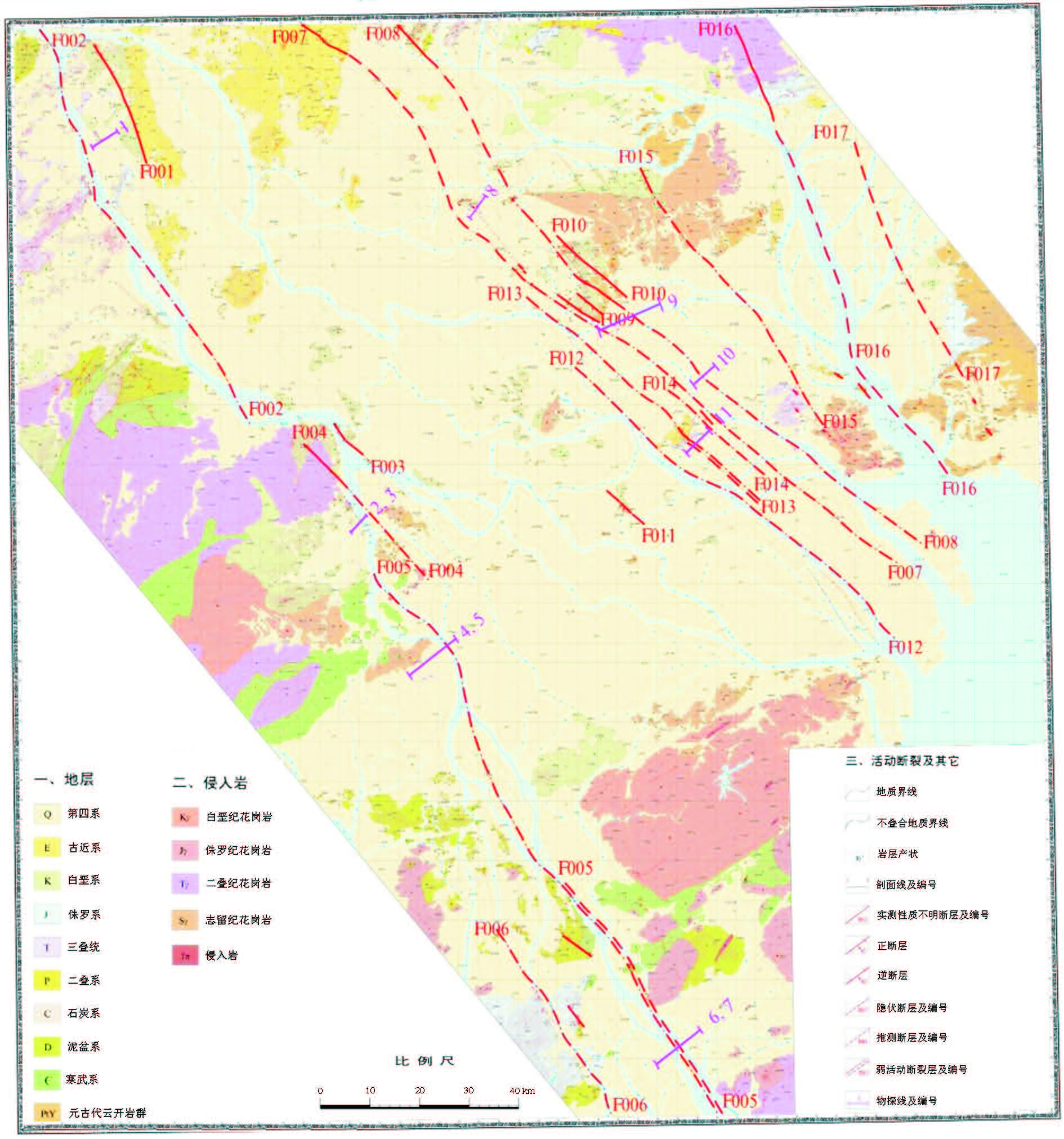
 下载:
下载:
